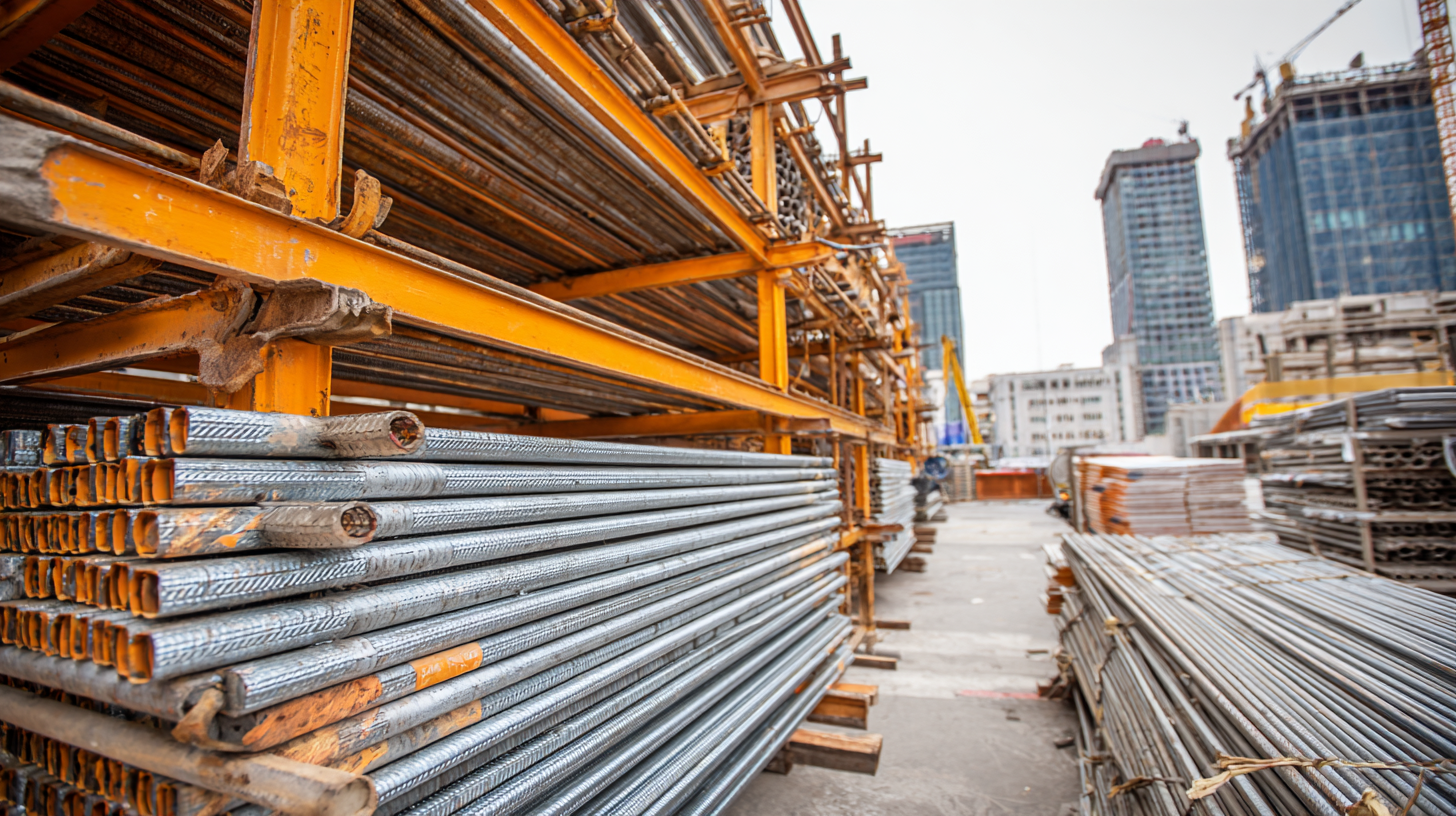 +86 18531741341
+86 18531741341
Leave Your Message
In recent years, the global scaffolding accessories market has witnessed significant growth, with China emerging as a key player in driving supply trends. According to a report by Research And Markets, the global scaffolding accessories market size was valued at approximately $9.53 billion in 2021 and is projected to reach $15.7 billion by 2028, growing at a CAGR of 7.5%. This surge is largely attributed to the booming construction industry and increased investments in infrastructure projects worldwide. As an essential component of construction safety and efficiency, scaffolding accessories have become critical in ensuring worker safety and project success. With innovative designs and advanced materials being adopted, China’s leading manufacturers are setting benchmarks and influencing standards across the globe, thus reshaping the dynamics of the scaffolding accessories market and providing numerous benefits, including enhanced durability, improved safety compliance, and cost-effectiveness for construction projects.

 China has emerged as a powerhouse in the scaffolding accessories market, influencing global supply trends significantly. The country’s advanced manufacturing capabilities and competitive pricing enable it to cater to the increasing demands of international construction projects. From scaffolding pins to safety nets, Chinese manufacturers are providing a vast array of products that align with global standards, making them a preferred choice for many construction companies worldwide.
China has emerged as a powerhouse in the scaffolding accessories market, influencing global supply trends significantly. The country’s advanced manufacturing capabilities and competitive pricing enable it to cater to the increasing demands of international construction projects. From scaffolding pins to safety nets, Chinese manufacturers are providing a vast array of products that align with global standards, making them a preferred choice for many construction companies worldwide.
Tips: When sourcing scaffolding accessories from China, it’s crucial to conduct thorough research on suppliers. Look for established companies with a reputation for quality and reliability. Additionally, consider the certifications held by these manufacturers, such as ISO standards, which can assure compliance with international safety requirements.
Moreover, staying abreast of market trends can give businesses a competitive edge. The growing focus on sustainability has prompted many Chinese manufacturers to innovate eco-friendly materials. Investing time to understand these trends can help you make informed procurement decisions that align with both quality and sustainability goals in your projects.
In recent years, China's scaffolding accessories industry has witnessed a remarkable transformation, aligning itself with innovative trends that cater to the evolving needs of global markets. As construction projects grow in scale and complexity, the demand for advanced scaffolding solutions has surged. Chinese manufacturers have responded by integrating cutting-edge technology and design into their products, ensuring that they not only meet safety standards but also enhance efficiency on job sites.
Among the key innovations emerging from China are modular scaffolding systems and lightweight materials that offer superior durability without compromising on strength. These advancements enable faster assembly and disassembly, significantly reducing labor costs and project timelines. Furthermore, as sustainability becomes a priority, many manufacturers are now adopting eco-friendly materials and practices, reflecting a commitment to environmental responsibility in the construction sector.
With a keen focus on research and development, Chinese companies are setting benchmarks in scaffolding accessories that are shaping global supply trends. By prioritizing innovation, these manufacturers are not only contributing to safer and more efficient construction practices but are also positioning themselves as leaders in the international scaffolding market. As such, the collaborative efforts between technology and traditional manufacturing in China are paving the way for a new era in construction solutions that promoters around the world are eager to embrace.
| Accessory Type | Material | Weight Capacity (lbs) | Market Share (%) | Innovative Features |
|---|---|---|---|---|
| Scaffolding Couplers | Steel | 5000 | 25 | Anti-corrosion coating |
| Adjustable Props | Aluminum | 3000 | 20 | Lightweight design |
| Ledger Beams | Steel | 6000 | 30 | Easy installation clips |
| Decking Boards | Plywood | 4000 | 15 | Slip-resistant surface |
The role of Chinese manufacturers in global construction supply chains has gained increasing significance, especially in the wake of the Covid-19 pandemic. As the construction market strives to adapt, China stands at the forefront, leveraging its extensive manufacturing capabilities to reshape supply trends. According to a recent report, over 60% of construction materials worldwide are sourced from China, highlighting the nation’s integral position in this sector. The pandemic-induced disruptions have not only emphasized the need for robust supply chains but also spotlighted the agility and resilience of Chinese manufacturers who have quickly adapted to changing market demands.

Moreover, the trend towards digitalization within Industry 4.0 is transforming these supply chains. A study shows that companies utilizing digital tools for supply chain management report a 30% increase in operational efficiency. Chinese suppliers are increasingly adopting advanced technologies to streamline processes, ensuring consistent and timely delivery. This digital transformation is essential as the global construction industry grapples with uncertainties and supply chain recalibrations, proving that Chinese manufacturers are not just participants but pivotal players in redefining global supply dynamics.
The scaffolding accessory industry in China has seen a significant shift towards sustainable practices, which reflects broader global trends in environmental responsibility. Manufacturers are increasingly integrating eco-friendly materials and processes into their production lines, reducing the carbon footprint of their operations. Innovations in recycling and waste management are becoming standard, allowing companies to reclaim and reuse materials effectively. This commitment to sustainability not only helps address the pressing issue of waste in construction but also aligns with international standards and regulations, positioning Chinese manufacturers as leaders in the global market.
Moreover, the emphasis on sustainability is driving technological advancements within the industry. Companies are investing in research and development to create lighter, more durable scaffolding accessories that require fewer raw materials without compromising safety and performance. This focus not only ensures competitiveness but also attracts eco-conscious clients seeking reliable partners who prioritize environmental stewardship. As the global supply chain evolves, China's commitment to sustainable practices in scaffolding accessories will likely set benchmarks for other nations and industries, fostering a culture of innovation while addressing the challenges of climate change.
This chart illustrates the increasing trend of China's contribution to the global scaffolding accessories market from the year 2020 to 2023, highlighting the growth in market share as sustainability practices become more prominent in the industry.
The global scaffolding accessories market is set for significant growth in the coming years, reflecting a projected compound annual growth rate (CAGR) of 5.8% from 2023 to 2028. As construction activities ramp up worldwide, driven by urbanization and infrastructure development, the demand for high-quality scaffolding accessories is surging. Notably, China, as a major manufacturer, plays a pivotal role in shaping these trends, supplying over 40% of the global market share. This dominance stems from advancements in production techniques and a robust supply chain network that boosts efficiency and reduces costs.
In addition to manufacturing prowess, sustainability is becoming a critical consideration in projections for the scaffolding accessories market. According to a 2023 report by Market Research Future, eco-friendly materials and practices are increasingly influencing buyer preferences, leading to a rise in the adoption of green scaffolding solutions. Companies that innovate in creating sustainable accessories not only align with global environmental goals but can also tap into new opportunities as regulatory frameworks tighten. As the industry evolves, these factors will shape the landscape, with Chinese manufacturers at the forefront of providing solutions that cater to current and emerging market needs.
